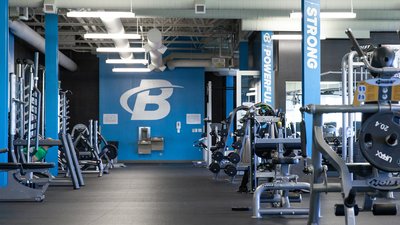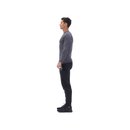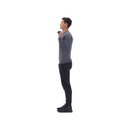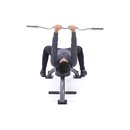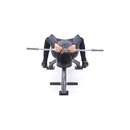Robby Robinson couldn't be bothered with Charles Darwin. He didn't have the patience to evolve, so he forced his own adaptation. He transformed his body with barbells, dumbbells and the iron clang of plates.
Gold's was his Galapagos. Rep after rep, Robinson pushed himself from sickly youth to fitness enthusiast to physique champion to bodybuilding legend. Using classic techniques and creative exercises, he forged some of the best arms in the iron game. Even today, at 65, his biceps form massive peaks, and the heads of his triceps surround deep canyons of striated muscle.
In addition to showcasing his champion arm routine, this series will also tell Robinson's story: the story of "Mr. Lifestyle," bodybuilding's one and only "Black Prince." After many years of silence, this self-built man sat down with Bodybuilding.com to share thoughts on training, nutrition, supplementation, and so much more.
The Stuff Of Legend
The Prince is held in high regard for his lofty achievements, class, and the slew of titles he amassed through his 26-year pro career. Over the course of a lifetime, he has played a major role in the worldwide promotion of health and fitness. Today, he is a vocal advocate for the athlete's lifestyle and the fight against aging.
He works tirelessly to help dreamers achieve the longevity and physical shape he so spectacularly embodies. At age 65, Robinson says he is in the best shape of his life. Check out his training video Built and dare call him liar.
Robinson grew up in the Deep South through the 1950s and '60s. Tallahassee, Florida - embroiled in the struggle for civil rights—wasn't exactly a conducive atmosphere for a young black man to distinguish himself in any field, much less bodybuilding, which has always required extreme self-promotion and overt physical display. Nonetheless, Robinson began weight training at 12, inspired first by Jack LaLanne.
He found courage from the rapid muscle gain his early training efforts stimulated, so young Robby began to compete. He suffered racial jeers and questionable judging in many of his 300-plus amateur bodybuilding competitions.
The hostile environment only made him stronger. It forced him to forge the positive, progressive mindset that distinguished his pro career. Patience and perseverance paid off. He placed fifth in the 1975 AAU Mr. America competition and became one of the highest-ranked amateurs in the United States.
The Prince And His Crown
In 1975, Robinson received an invitation from bodybuilding impresario Joe Weider to move to California. When Robinson arrived, the legendary Venice Beach Gold's Gym and Muscle Beach were just green shoots of the burgeoning fitness community. Robinson quickly endeared himself to fellow bodybuilders and fans alike. He was even asked by Weider to take part in the epoch-defining film, Pumping Iron.
Success came fast and furious before that was a movie. He won the 1975 IFBB Mr. America and Mr. World titles, which he followed in 1976 with IFBB Mr. International and Mr. Universe victories. In 1977, he won his class at the exalted Mr. Olympia competition, a feat he repeated in 1978. He spent most of the 1980's living in the Netherlands, touring the world, instructing, and competing.
He won the initial IFBB Masters Mr. Olympia Championship in 1994, beating out fellow icon Lou Ferrigno. Robinson retired after a fourth-place finish at the 2001 Masters Mr. Olympia at 54-years young.
Always Number One
Robinson's bodybuilding career was marked by firsts. He was the first black man featured prominently on muscle magazine covers, first Masters Mr. Olympia champion (1994), first pro bodybuilder to demonstrate pro-level definition and development into his mid-60s, and the only black American bodybuilder to receive a feature spot in the landmark bodybuilding movie Pumping Iron.
Among these victories, Robinson has always been known for his tremendous arm development. Looking at Robinson's arms - even and especially now - is like looking at a landscape of ridges, peaks, valleys and cuts. If you want ridges like Robinson, prepare to train like a legend.
Legend-At-Arms Workout
Robinson trains biceps and triceps twice per week, hitting tris before bis. He trains three days in a row, takes one day off, and then repeats the cycle. To keep up the high frequency, Robinson alternates between light and heavy workouts each week.
Heavy Day: First set of each exercise 15-20 reps; subsequent sets: 5-10 reps. 4 sets per exercise.
Light Day: First set of each exercise 20 reps; subsequent sets: 10-12 reps. 4 sets per exercise.

BodyFit
$6.99/month- 2,500+ expert-created single workouts
- 3,500+ how-to exercise videos
- Detailed workout instruction
- Step-by-step workout tips
- Training at gym or at home
- Access to Workout Plans
- Access to Bodyfit App
- Store Discounts
Already have a Bodybuilding.com account with BodyFit? Sign In

What comes with BodyFit?

- Instructional Videos
Don't risk doing a workout improperly! Avoid injury and keep your form in check with in-depth instructional videos.

- How-to Images
View our enormous library of workout photos and see exactly how each exercise should be done before you give it a shot.

- Step-by-Step Instructions
Quickly read through our step-by-step directions to ensure you're doing each workout correctly the first time, every time.

BodyFit
$6.99/month- 2,500+ expert-created single workouts
- 3,500+ how-to exercise videos
- Detailed workout instruction
- Step-by-step workout tips
- Training at gym or at home
- Access to Workout Plans
- Access to Bodyfit App
- Store Discounts
Already have a Bodybuilding.com account with BodyFit? Sign In

What comes with BodyFit?

- Instructional Videos
Don't risk doing a workout improperly! Avoid injury and keep your form in check with in-depth instructional videos.

- How-to Images
View our enormous library of workout photos and see exactly how each exercise should be done before you give it a shot.

- Step-by-Step Instructions
Quickly read through our step-by-step directions to ensure you're doing each workout correctly the first time, every time.
*Take a 20-pound bar and bend over as if doing a stiff-legged deadlift, but hold the bar behind you. Raise the bar by extending your arms and hinging at the elbows. Flex your triceps at the top of the move, when the bar is parallel with the floor.
The Prince's Training Tips
1. Shape,Then Size
It is often assumed that Robby was simply blessed with remarkable symmetry, definition and separation. To an extent, that's true, but Robinson is quick to note that his training is geared toward encouraging shape rather than mindless mass gain.
To encourage shape development, Robby attacks his muscles from all angles and mixes his sessions with cables and isolation movements atypical from the hardcore bodybuilding elite.
For example, he frequently uses the Preacher curl - a shaping movement - to build his massive biceps peaks.
2. Lighten Up
To maintain his impressive size, while ensuring his trademark separation, Robby includes heavy and light training days. During the latter, he focuses on bringing in his separation and upping the rep count to promote the kind of shape he is renowned for.
3. StretchYour Limits
On all movements, Robby is sure to stretch his muscles fully to encourage full muscular development. By stretching he can change a muscle's shape, pulling apart the fascia that surrounds muscle fiber bundles.
4. Passion
Robinson has been lifting for 45 years because, quite simply, he loves training. It's an art. He still seeks perfection and further muscular refinement.
While many bodybuilders concede to the ravages of age, Robby continues to defy it by remaining on the cutting edge of elite-level training, a process he truly enjoys.
5. Progress Makes Perfect
If he can achieve a single deadlift rep with 700 pounds, Robby will then envision completing several reps with 600. By constantly pushing the pace and making gradual improvements, he is able to continue refining his already incredible development.
At age 65, bodybuilding's Black Prince is in the best shape of his life and shows no signs of slowing down.
In His Own Words
In addition to sharing his excellent arm routine and unique tips, Robinson had much to say about his training philosophy, technique, and passion for bodybuilding.
Q.How is your training going these days? How do you stay so damn young?
I'm still doing the same kind of system; three days on and one day off. I just really love to train. You would think by now that the thrill would have worn off. But to be honest with you, David, I'm stronger now than when I was competing. A lot of that comes down to really taking good care of myself. I really did a great job of it during my career, and have done an even better job during the last 12 years.
After training three days on, one off, I repeat the cycle. I have a heavy week of lifting, then a lighter week. I go back and forth between those two cycles in those four days.
Also, I've always been a big believer in the basics. I'll grab a bench and do inclines just to keep the girth and the size there. On the lighter days I'll just switch to dumbbells and cables. I will do 15 sets per body part on heavy days and on 18 on light days.
It seems to me that you haven't lost your passion for bodybuilding, despite being in the game for more than 45 years.
I just love going into the gym and challenging myself. I think back to the old days and all the guys I used to train with back then. I look up at the champion's pictures at Gold's when I'm training there. I will be looking up at Frank Zane's picture and doing chins.
I still look up to the people who inspired me in the old days. That's where a lot of my motivation comes from. In those days, you went into the gym and it was back day, and if Arnold did 20 reps on the long seated row, then we all did 20 reps on the long seated row.
If Kenny Waller did 10 reps with 150 [pound dumbbells], you had to do the same. It was a joyous time, and I loved every moment of it. I'm still motivated by that time period
Even though there was a competitive element among the guys, it seems like the camaraderie was strong.
Oh yeah, we did everything together. We trained together, ate breakfast together, tanned on the beach together. Our life was like one big party. Everybody was in the gym at the same time. The energy flow was continuous and you couldn't help but be swept away by it.
What's different about your current program compared with the one you used back in the '70s?
After retiring [in 2001], I went back to the basics and my weight stabilized at about 215 pounds. Then I created a website and a master class where people come from all over the world to be trained by me. I was booked in 2011 from April through to September/October.
My classes are year round with bodybuilders, couples and general fitness clients. I created a Crystal Globe Award for the guy who comes into the master class in the best shape. I'm doing a lot of positive things. I love what I'm doing and I'm having a great time.
Among other attributes, you're known for your tremendous arm development. How did you develop your biceps peaks? Was such development largely genetic? Or did you work hard to build them?
One of the biggest things for me has been to focus on training the triceps hard, because it has more muscle [than the biceps] with its three heads. I pay a lot more attention to the three heads and do more anchor stuff for the biceps. For example, I do Scott curls and Zottman curls off a bench [for biceps].
I think the anchored arm creates more biceps size, power and stretch. If you are not stretching the biceps, you are definitely not going to have the high peak. I will always basically start with the triceps on heavy days, when training arms, because it has the most heads. I will work a lot on extensions, close-grip triceps presses and kickbacks. With biceps it will be Zottman curls and reverse curls to work on both muscle size and shape.
I always work a lot on the shape of the muscle groups, for all body parts, and lighter weight creates that shape - that broad-shouldered, capped look. I use a lot more cables and dumbbells on occasions. I believe in heavy and light days. And then I have days when I go for my max weight, days when I am pushing 2,000 pounds for 15 reps on leg presses.
I am stronger now than I was back in the 1970s. I think a lot of it is experience.
What specific biceps and triceps training tips can you provide?
I have always combined barbell curls with the Scott (preacher) bench, and choose the harder exercises for each muscle group. Building that foundation is one of the reasons I have been able to look the way I do at age 65. The basics just seem to keep my physique there; maintain my 20-inch arms. I do very little for my abdominal area - 100 twists with a broom handle and hanging leg raises and that's it.
For biceps I will do Zottman curls off a bench followed by Scott bench curls and then I'll do five reps of standing barbell curls - five reps for each movement. I do four [sets] on the lighter days and three [sets] on heavier days. I'm a big fan of reverse curls with the EZ-curl bar. I like this exercise. It builds shape in the brachialis area and brings in the forearm development and ties all the smaller muscle groups together to create a better and bigger arm, a better-looking arm.
Heavy days: on my first set it is 15-to-20 reps to warm up, and then I drop it down to between 5-10, and occasionally three. Light days: first set is 20 reps to get the blood in there. Now, you have already built that muscle, so I'm working on shaping and bringing in all those smaller surrounding muscle groups to make the muscle look bigger.
For triceps, there's an old Larry Scott favorite where you take a 20-pound bar and bend over as if doing a stiff-legged deadlift, but the bar is behind you. You then you push it all the way to parallel while flexing the triceps. That's my all-time favorite.
Do you use any machines in your training?
Yes. I face forward on the pec dec machine and use the pads to extend my arms back to work the trapezius and rear delts. But I'm basically a barbell, dumbbell and cable person.
Your conditioning is always right on. Do you rely much on cardio to strip body fat?
Back in the day we would run the Santa Monica stairs, but there wasn't much else. I didn't get into aerobics until I competed in the Masters Olympia. I found a level for me where I can walk the treadmill for one minute on flat, one minute elevated and so on for 15-20 minutes, 2-3 times per week. This hits me perfect. And I have been doing this for almost 15 years.
As you get older you kind of have to rev things up a little. There is something about those Santa Monica stairs, though; I run them from top to bottom - there are 189 stairs and I do this probably 2-3 times.
On my heavy days, when I really want to pound the cardio, I go down to the stairs and take two 50-pound dumbbells and walk them using this weight. I just love being in good physical shape, being fit and healthy. I think it pays off.
Watching you train, what first becomes apparent is your remarkable form. How important to you is training technique?
I think the form, the technique, is what creates a great physique. Maintaining an upper back arch and breathing in and out of your nose. All of these little things I try to apply in my routine regardless of what body part I'm training. And I also use a lot of visualization: seeing the muscle the way I want it to look.
At 65, I still go in the gym and aim to build an impressive physique. I'm not going to compete anymore, but just the feeling of standing there with 500 pounds on the bar is great. I have the same feeling now as I did when I first walked into a gym; I love to train.
I don't think I've ever gone in the gym and had a bad workout. With all of the equipment they have these days, there is always some way to be creative.
Judging by your online videos you are indeed moving some serious weights these days.
I believe nutrition plays a huge role in this. Last month I did a photo shoot for Ironman and did heavy squats. I was up, like, 545 [pounds] for a double. So my strength has improved and a lot of this has to do with nutrition.
Eating good meals, staying very positive, and focusing on everything it takes to stay in good shape.
More to Say
Interested in what Robinson has to say on "everything it takes to stay in good shape"? Check back soon for additional exclusive content with the Black Prince. Robby discusses nutrition, supplementation, his competitive career, struggles and failures, bodybuilding politics, Pumping Iron, his new book, and much more. Come back to the Prince's court for another dose of unique content.


